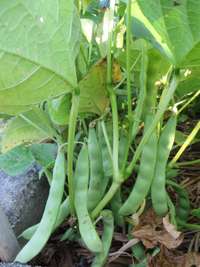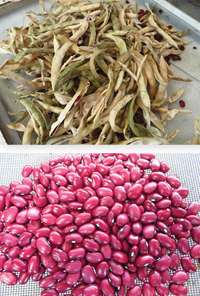
Figure 13. Adzuki bean pods. Source: Holly Sobetski
Adzuki bean (Vigna angularis; Figure 13) is native to eastern Asia and the major world producers are China, Japan, Taiwan, and South Korea (Shahrajabian et al., 2019). People have introduced adzuki bean around the world for its versatility as a cover crop, its nutritional value, and its use in traditional Asian cuisine which now spans the globe.
Soils and climate
Adzuki bean grows best in well-drained loams or intermediate-textured soils with a pH from 5.5 to 7.5 (FAO, 2024). As a legume, adzuki bean fixes nitrogen in the presence of rhizobial bacteria, converting atmospheric nitrogen to nitrogen plants can use. Growing adzuki beans in soils with Bradyrhizobium near neutral pH (7.0) maximizes their nitrogen fixation (Shahrajabian et al., 2019 and Hardman et al., 1989).
Minimum and maximum temperatures for growth of adzuki beans are 10 to 32°C with the best plant growth between 18 and 23°C (Torabian et al., 2021). Low temperatures at planting delay emergence and favor root rot.
Cultivation
Plant adzuki bean in well-prepared soil at a depth of 3.8 cm, ensuring good seed-to-soil contact for adequate water absorption and protection (Hardman et al., 1989). Planting distance can vary to adjust for intercropping, grain production, or dense plantings for green manure/cover cropping. Torabian et al. (2021) recommended an in-row spacing of 2.5 to 7.5 cm and a between row spacing of 30 (without an intercrop) to 75 (with an intercrop) cm. Denser plantings and pure stands cover the soil well and produce greater biomass for incorporation into the soil or mulch.
Seedlings emerge 10 to 14 days after seed sowing and up to 20 days after sowing at lower temperatures of 10 to 13°C (Hardman et al., 1989). Early growth is slow (Belfry and Sikkema, 2018), making adzuki bean a poor competitor with weeds. Adzuki beans do not need high levels of nutrients .
Fertilize at rates per hectare of11-45 kg N,17-34 kg P2O5, and 22-67 kg K2O, depending on soil organic matter and desired yield (Hardman et al., 1989). When grown as a cover crop, incorporate the biomass into the soil or chop and drop as mulch early in the flowering stage when symbiotic nitrogen fixation and plant concentration of nitrogen are at their highest levels.

Figure 14. Adzuki bean mature pods (top) seeds (bottom). Source: Holly Sobetski
Plants grow to 46 to 64 cm and mature in 110 to 120 days (Hardman et al., 1989) with pods and stems in different stages of development because of adzuki bean’s indeterminate growth pattern.
If growing for seed multiplication, harvest seeds when leaves and pods are yellowing and shedding, with loose seeds in the pod (Figure 14). Ideal seed moisture content at harvest is 16 to 20% (Torabian et al., 2021).
Pests
Thrips (Thripidae) and jassids (Cicadellidae) infest adzuki bean seedlings (Torabian et al., 2021). Examples of specific thrips are Megalurothrips usitatus (Khan et al., 2022). Jassids are the green rice leafhopper (Nephotettix cincticeps; Bae et al., 2015).
Mirids like Creontiades dilutus and C. pacificus infest adzuki beans (NIPI, 2012) from flowering through pod set/fill/ripening and harvest. These pests are preferentially attracted to alfalfa (Medicago sativa) which makes it a potential trap crop to help combat this pest.
Lepidopteran pests in their caterpillar phase are common and vary by location, like the adzuki bean borer (Ostrinia scapulalis) which is common within the native range of adzuki bean. Helicoverpa spp. [ formerly Heliothis]) are often major pests of adzuki bean. Damage is apparent by bite marks on leaves, frass or excrement, and eggs.
The adzuki bean weevil or cowpea bruchid (Callosobruchus chinensis), is a pest of stored grain. Rajapakse and Ratnasekera (2010), determined that neem (Azadirachta indica), Custard Apple (Anona reticulata), and Holy Basil (Ocimum sanctum) resulted in 90 to 100% mortality of the pest in stored grain.
Diseases
White mold (Sclerotinia sclerotiorum) and bacterial stem rot [(Pseudomonas amygdali pv. adzukicola nov.) Todai et al., 2022] are common to adzuki bean (Hardman et al., 1989). Powdery mildew and common bacterial wilt are often present.
Different growing conditions and locations will have different pests and diseases that affect adzuki beans. Consult local experts to identify pests and diseases and implement proper cultural and natural controls, if possible, before using chemicals as a last resort.
Culinary and nutrition
When preparing the paste known as ‘an’ used in traditional Asian cuisine, cook adzuki beans for 50 minutes, then soak beans in sugar water for 2 hours at a pH of 8. This process helps retain the seed coat which contains much of the nutritive and antioxidant value of the crop (Yao et al., 2014). Aslinah et al., (2018) found that adzuki bean meal serves as a meat extender and fat replacer. You can sprout adzuki beans for their bioactive properties,4 which peak three days after root emersion and decline by seven days (Li et al., 2011); it is the preferred bean in both traditional Asian dishes and medicine.
References
Aslinah L.N.F., M. Mat Yusoff, and M.R. Ismail-Fitry. 2018. Simultaneous use of adzuki beans (Vigna angularis) flour as meat extender and fat replacer in reduced-fat beef meatballs (bebola daging). J Food Sci Technol 55(8):3241-3248. doi: 10.1007/s13197-018-3256-1.
Bae, S., J. Park, B. Mainali, H. Kim, Y. Yoon, Y. Lee, and Y. Cho. 2015. Evaluation of different light colors in solar trap as attractants to cereal and legume insect pests. Korean J. Int. Agric. 27(4):516-521. http://dx.doi.org/10.12719/KSIA.2015.27.4.516
Belfry, K. and P.H. Sikkema. 2018. Weed management in adzuki bean: a review. Canadian Journal of Plant Science. 98(6): 1221-1233. https://doi.org/10.1139/cjps-2018-0026
Food and Agriculture Organization and IIASA . 2024. Vigna angularis. ECOCROP, Global Agro Ecological Zones version 4 (GAEZ v4) [Accessed 10 December 2024] URL: https://gaez.fao.org/pages/ecocrop-find-plant
Hardman, L.L., E.S. Oplinger, J.D. Doll, and S.M. Combs. 1989. Adzuki bean. Alternative Field Crops Manual. University of Wisconsin, Madison, WI, USA. http://corn.agronomy.wisc.edu/Crops/AdzukiBean.aspx
Khan, R., D. Seal, and R. Adhikari. 2022. Bean flower thrips Megalurothrips usitatus (Bagnall) (Insecta: Thysanoptera: Thripidae). University of Florida Institute of Food and Agricultural Sciences (IFAS) Extension Pub. EENY-777. Gainesville, FL, USA https://doi.org/10.32473/edis-IN1352-2022
Li, L., B. Liu, and X. Zheng. 2011. Bioactive ingredients in adzuki bean sprouts. Journal of Medicinal Plants Research 5(24):5894-5898.
National Invertebrate Pest Initiative (NIPI). 2012. Mirids - IPM Guidelines for Grains. Queensland Department of Agriculture and Fisheries. Queensland, Australia. https://ipmguidelinesforgrains.com.au/pests/mirids-in-soybean/ and https://ipmguidelinesforgrains.com.au/important/uploads/Mirids.pdf
Rajapakse, R.H.S. and D. Ratnasekera. 2010. Pesticidal potential of some selected tropical plant extracts against Callosobruchus maculates (F) and Callosobruchus chinensis (L)(Coleoptera: Bruchidae). Tropical Agricultural Research and Extension 11.
Shahrajabian, M. H., W. Sun, M. Khoshkharam, P. Zandi, and Q. Cheng. 2019. Adzuki beans (Vigna angularis), a traditional Chinese legume for sustainable agriculture and food production. Journal of Biological and Environmental Sciences 13(38):79-84.
Todai, T., F. Takahashi, S. Yasuoka, and T. Sato. 2022. Pseudomonas amygdali (syn. Pseudomonas savastanoi) pv. adzukicola pv. nov., causal agent of bacterial stem rot of adzuki bean. Journal of General Plant Pathology 88(6). DOI:10.1007/s10327-022-01084-3
Torabian, S., R. Qin, D. Wysocki, and X. Liang. 2021. Adzuki Bean: A potential rotational crop for the columbia basin. Oregon State University Extension Service. Corvallis, OR, USA. https://extension.oregonstate.edu/pub/em-9332
Yao X., L. Shuwen, X. Zheng, S. Jingkun, R. Chuanying, Z. Yinglei, X. Xuejun, and S. Xiangdong. 2014. Effect of cooking conditions on quality of sweetened adzuki an. Int J Agric & Biol Eng. 7(4):134-142.